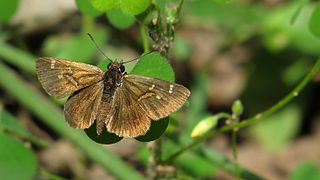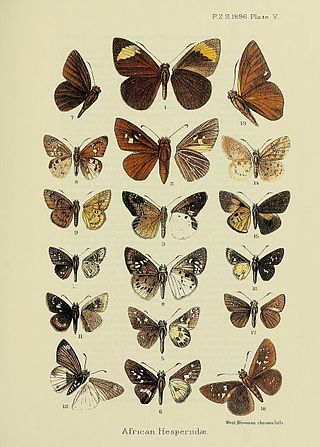
Skippers are a group of butterflies placed in the family Hesperiidae within the order Lepidoptera. They were previously placed in a separate superfamily, Hesperioidea; however, the most recent taxonomy places the family in the superfamily Papilionoidea, the butterflies. They are named for their quick, darting flight habits. Most have their antenna tips modified into narrow, hook-like projections. Moreover, skippers mostly have an absence of wing-coupling structure available in most moths. More than 3500 species of skippers are recognized, and they occur worldwide, but with the greatest diversity in the Neotropical regions of Central and South America.

The Celaenorrhinini are a tribe of spread-winged skippers in the skipper butterfly subfamily Tagiadinae.

Euschemon is a genus of skipper butterflies in the family Hesperiidae. It is monotypic, being represented by the single species Euschemon rafflesia, commonly known as the regent skipper and is found in Australia.

Aurina is a genus of skippers in the family Hesperiidae, in which it is placed in tribe Phocidini.
Cabirus is a genus of skippers in the family Hesperiidae. It is monotypic, being represented by the single species Cabirus procas.

Carcharodus is a Palearctic genus of skippers in the family Hesperiidae.

Ge is a genus of grass skipper butterflies in the family Hesperiidae described by Lionel de Nicéville in 1895. It is monotypic, containing the single species Ge geta, described in the same publication, and is found in Borneo, Sumatra, Nias, Batoe, Java, Burma, Thailand, Langkawi and Malaya.
Misius is a genus of skippers in the family Hesperiidae. It is monotypic, being represented by the single species Misius misius.
Molla molla is a species of skipper butterfly in the family Hesperiidae. It is the only species in the monotypic genus Molla.

Muschampia is a Palearctic genus of spread-winged skippers in the family Hesperiidae.
Pamphilites is an extinct genus of skippers in the family Hesperiidae. It contains only one fossil species, Pamphilites abdita, recovered from the Tertiary of Aix-en-Provence, France.

Pudicitia is a genus of grass skippers in the family Hesperiidae. It is monotypic, containing the single species Pudicitia pholus from Assam and Bhutan.
Punta punta is a species of skipper butterfly in the family Hesperiidae. It is the only species in the monotypic genus Punta.

Sovia is a genus of grass skipper butterflies in the family Hesperiidae. The species are found in the Indomalayan realm The genus was erected by William Harry Evans in 1949
Systaspes is a genus of skippers in the family Hesperiidae. It is monotypic, being represented by the single species, Systaspes corrosus.

Toxidia is a genus of butterflies in the subfamily Trapezitinae of family Hesperiidae. The contained species are found in the Australasian realm.

Pasma tasmanicus, the two spotted grass skipper, is the only species in the monotypic butterfly genus Pasma of the family Hesperiidae. The genus was erected by Gustavus Athol Waterhouse in 1932. The species was first described by William Henry Miskin in 1889. It is found in the Australian states of New South Wales, South Australia, Tasmania and Victoria.

The Erionotini are a tribe of skipper butterflies in the subfamily Hesperiinae.

Ortholexis melichroptera, the black scarce sprite, is a species of butterfly in the family Hesperiidae. It is found in Ghana, Nigeria, Cameroon and Gabon. The habitat consists of dense primary forests.













